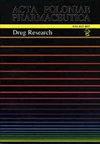共聚焦激光扫描显微镜研究双氯芬酸钠微乳液的透皮渗透行为
IF 0.4
4区 医学
Q4 PHARMACOLOGY & PHARMACY
引用次数: 0
摘要
目的:研究新型微乳体系双氯芬酸钠的体外透皮及透皮行为。方法:将双氯芬酸钠掺入油包水(0 /w)和油包水(w/o)微乳中,该微乳由2:1的Cremophor RH 40: Span 80为表面活性剂相,2:1的棕榈酸乙己酯为油相,2:1的水∶异丙醇为水相组成。采用Franz扩散池测定离体皮肤透性。用透射电镜(TEM)对微乳的形貌进行了表征。通过荧光标记和共聚焦激光扫描显微镜(CLSM)观察穿透深度分布。结果:0 /w型提供了增强的渗透通量,与w/o型相比,皮肤的渗透系数增加了3倍以上。形貌表征表明,o/w型和w/o型均为纳米级球形。CLSM观察发现,与w/o型(150 μm)相比,o/w型(220 μm)能显著促进硫磺胺B (SRB)渗透到更深的皮肤层(220 μm)。结论:本研究证明双氯芬酸钠微乳具有透皮性,其透皮性取决于微乳的微观结构和组成。本文章由计算机程序翻译,如有差异,请以英文原文为准。
Investigation of transdermal permeation behavior of diclofenac sodium microemulsion by confocal laser scanning microscopy
Purpose: To investigate the in vitro skin permeation and transdermal behavior of diclofenac sodium using a new system of microemulsion.
Methods: Diclofenac sodium was incorporated into oil-in-water (o/w) and water-in-oil (w/o) microemulsions consisting of a 2:1 ratio of Cremophor RH 40: Span 80 as surfactant phase, ethylhexyl palmitate as oil phase, and a 2:1 ratio of water: isopropanol as aqueous phase. Franz diffusion cell was used to determine the in vitro skin permeation. Morphology of microemulsions were characterized by transmission electron microscopy (TEM). The depth of penetration distribution was visualized by fluorescently labelling, and observing using confocal laser scanning microscopy (CLSM).
Results: The o/w type provided an enhanced permeation flux, with more than a 3- fold increase in permeability coefficient across skin as compared with w/o type. The morphology characterization indicated that both o/w and w/o type were nano-sized and spherical in shape. It was observed by CLSM that o/w type significantly facilitated the penetration of sulforhodamine B (SRB) to the deeper layers of the skin (220 μm) than w/o type (150 μm).
Conclusion: This study demonstrates that diclofenac sodium microemulsion can be transdermal, and the skin penetration depends on the microstructure and composition of microemulsion.
求助全文
通过发布文献求助,成功后即可免费获取论文全文。
去求助
来源期刊
CiteScore
0.80
自引率
0.00%
发文量
74
审稿时长
6-12 weeks
期刊介绍:
The international journal of the Polish Pharmaceutical Society is published in 6 issues a year. The journal offers Open Access publication of original research papers, short communications and reviews written in English, in all areas of pharmaceutical sciences. The following areas of pharmaceutical sciences are covered: Analysis, Biopharmacy, Drug Biochemistry, Drug Synthesis, Natural Drugs, Pharmaceutical Technology, Pharmacology and General.
A bimonthly appearing in English since 1994, which continues “Acta Poloniae Pharmaceutica”, whose first issue appeared in December 1937. The war halted the activity of the journal’s creators. Issuance of “Acta Poloniae Pharmaceutica” was resumed in 1947. From 1947 the journal appeared irregularly, initially as a quarterly, then a bimonthly. In the years 1963 – 1973 alongside the Polish version appeared the English edition of the journal. Starting from 1974 only works in English are published in the journal. Since 1995 the journal has been appearing very regularly in two-month intervals (six books a year). The journal publishes original works from all fields of pharmacy, summaries of postdoctoral dissertations and laboratory notes.

 求助内容:
求助内容: 应助结果提醒方式:
应助结果提醒方式:


